Power BI vs SSRS: Ultimate Comparison Guide [2024]
- -
- Time -
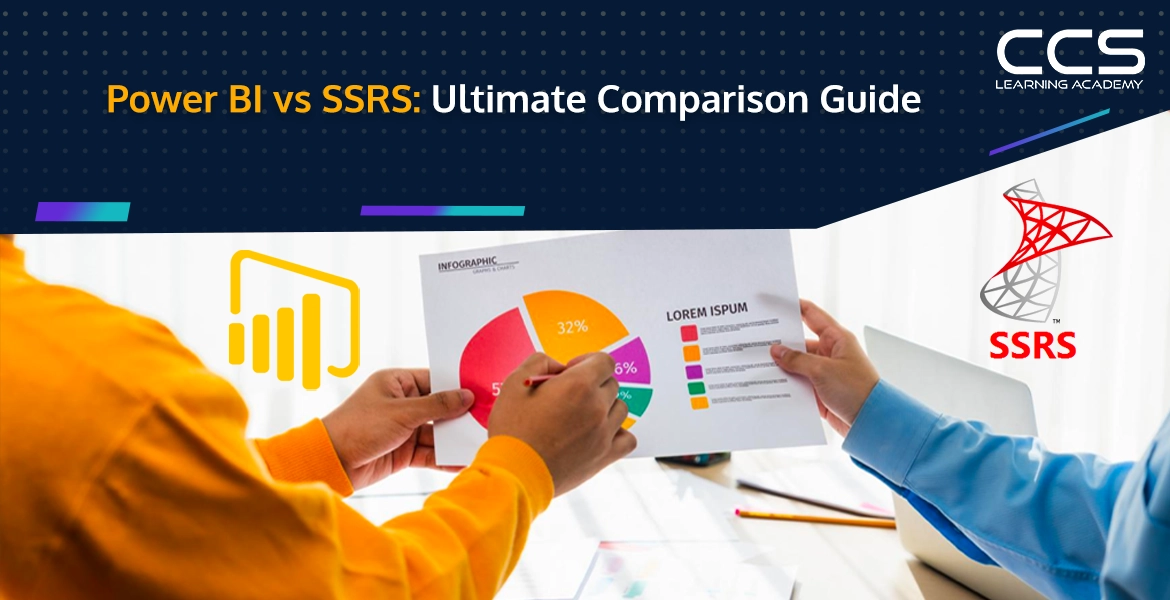
Microsoft is a popular technology platform that offers many valuable products. All the products are well-structured and useful. Power BI and SSRS are the two popular products in this new age. Both tools are good at their places, but having a detailed study is essential. Though both tools work to provide a seamless experience for preparing reports and analyzing data, they differ in many aspects.
Power BI and SSRS can help you gain insights on a large dataset. You only need to subscribe to any of them and analyze your data using them. The comparison study of Power BI vs SSRS will help you understand the difference between them and allow you to choose anyone depending on your needs and suitability. So, let’s look at this ultimate guide that provides extensive knowledge of both Power BI and SSRS
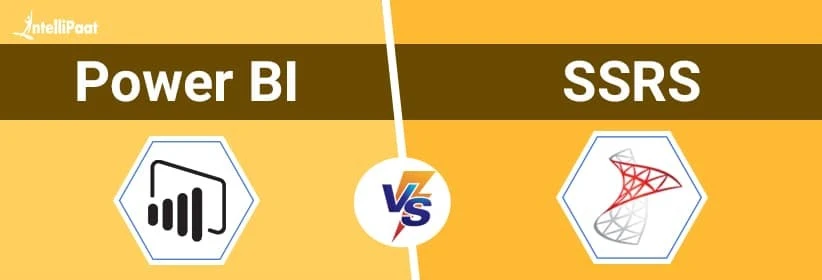
What Do You Know About Power BI?
Power BI is a data analysis, visualization, and business intelligence software that analyzes and manages big data sets. Its analysis and observations develop meaningful insights in charts, graphs, reports, and dashboards. The Power BI tool is mainly used for data cleaning, preparation, modeling, and reporting.
It helps expand the reach of data analytics and provides advanced capabilities like custom visuals and DAX formulas. Furthermore, Microsoft Power BI was developed in 2014 by Microsoft. It generates cloud- and server-based reports, dashboard modernity, and drag-and-drop interface. You can check out this PL-300: Microsoft Power BI Data Analyst CCSLA course to learn more about Power BI.
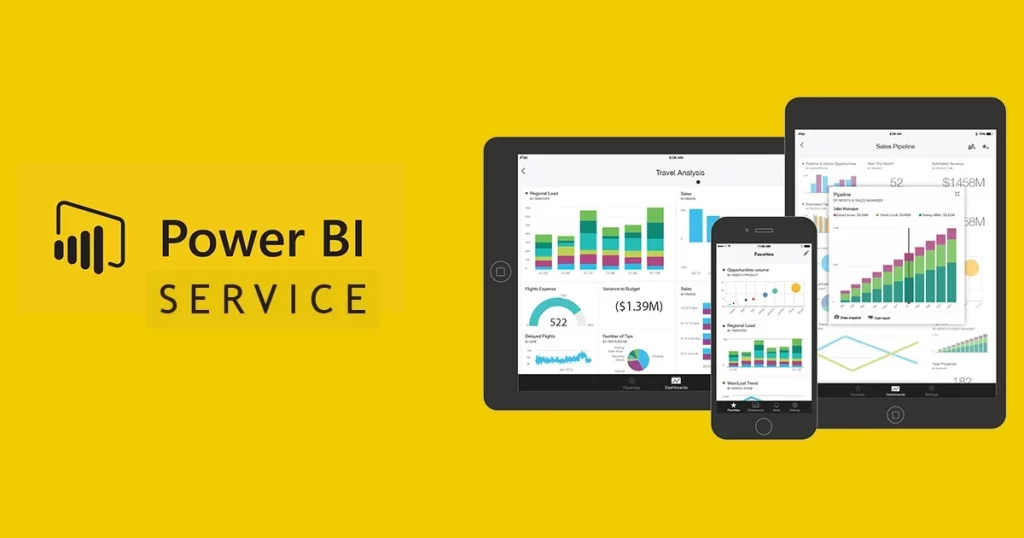
Pros of Power BI
There are many advantages of using Power BI tools to seek dynamic and meaningful insights. It facilitates every type of business, ranging from small to big. Organizations must assess their strength to achieve their long-term and short-term goals.
Following are some benefits that you should understand about Power BI:
- Real-time Data Analysis: Power BI helps update data and dashboard sharing. It encourages real-time analysis and facilitates immediate insights into valuable data.
- Regular Updates: Microsoft Power BI keeps its interface updated and new. Various advanced features and designs are updated now and then. Frequent updates are necessary to improve the platform; thus, Microsoft focuses on regular updates.
- Integration Capabilities: You can integrate Power BI with different Microsoft products and other third-party platforms without complexity.
Cons of Power BI
To better understand Power BI vs SSRS, you must also consider certain cons of Power BI.
Here are the disadvantages you should know:
- Advance Reporting Complexity: You may face specific problems when preparing advance reports. Basic reports are easy to design, but building intricate ones may face a steeper learning curve.
- Limitations on Data Size: Data size limits are set for the free version of the tool. Handling extensive datasets may not be suitable for analysis on a free version.
What is SQL Server Reporting Service (SSRS)?
SQL Server Reporting Services (SSRS) is an enterprise-level platform that Microsoft also provides. It is a part of the SQL server suite and helps you create, manage, and deliver traditional paper-driven reports.
The interactive web-based report can be easily made with this. Along with this, organizations use SSRS to produce reports in the form of matrix, tabular, and graphical representations. Know how to integrate and use SSRS tools with CCSLA: SQL Server Integration Service course.
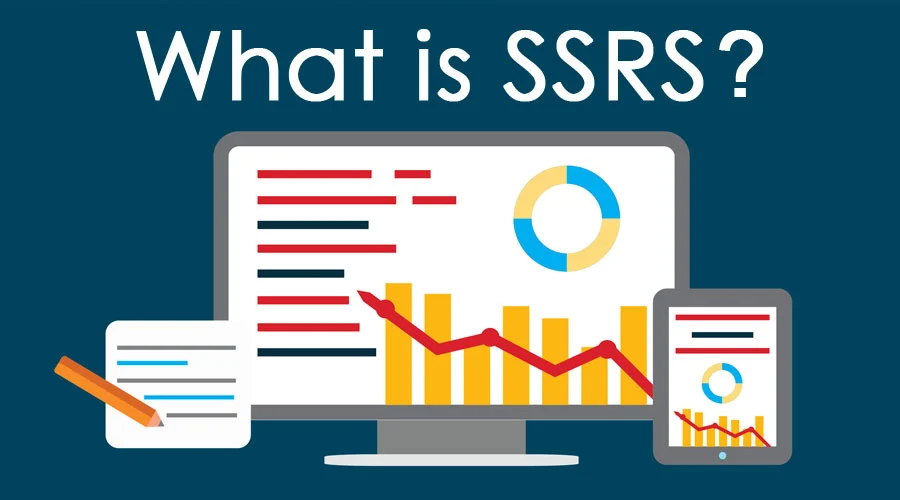
This server can be accessed on any device or operating system if you use this server to create free-form reports. You can also export it in PDF, Word, and Excel formats. It has various robust features and customizable reporting options. So, you can create reports from multiple data sources like multidimensional and relational databases.
Pros of SSRS
Evaluating different factors of tools is necessary before deciding which is better. Similarly, knowing the benefits of SSRS will help you understand how Power BI vs SSRS differ.
So, here are some advantages of SSRS that you must know:
- Integrated SQL Server: Microsoft SQL server suite allows SSRS to offer its integration feature to users. It streamlines the data retrieval process and generates reports within a few minutes.
- Flexibility in Creating Reports: The SSRS interface plays a significant role. Its user-friendly interface enables you to create complex and visual appeals.
- Supports Multiple File Formats: When you want to export your report, you can convert the files into any format you want. It supports PDF, Excel, Word, and many other formats that help users illustrate their reports more understandably.
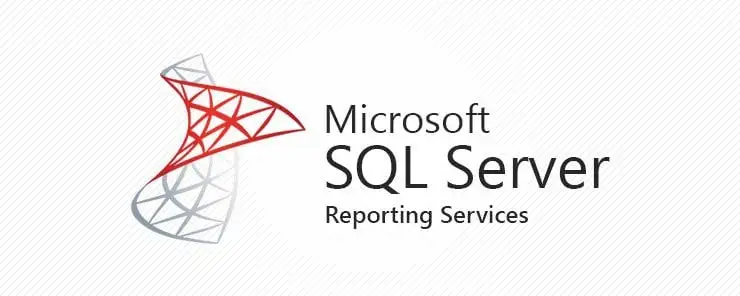
Cons of SSRS
With pros come cons, too. SSRS also has some disadvantages that users must know before using this tool.
The following are some limitations of SSRS:
- Web-based Limitations: The web-based interface of SSRS is less dynamic and promising than new modern web applications. It needs interactivity and user experience.
- Steeper Learning Curve: If you use SSRS, you may face several complexities as a beginner. And if you need to become more familiar with Microsoft products, you will find SSRS challenging at first.
- Lack of Advanced Visuals: Unlike Power BI, SSRS offers different advanced data visualization capabilities.
- Complex Integration with Non-Microsoft Products: SSRS seamlessly integrates Microsoft products and offers the best solutions. However, users might need help with incorporating non-Microsoft products with it.
How Do We Differentiate Between Power BI and SSRS?
When differentiating Power BI and SSRS, you should understand that both offer server reporting services. The significant difference between them is their interface and data handling process. Power BI has a user-friendly interface, while SSRS is more complex. SSRS requires coding skills to prepare reports.
However, on Power BI, you can handle data upto 1GB in the free version, and in the paid version, it can take 10GB of data per user. Furthermore, SSRS can handle a massive amount of data without any problem. You only need to put codes and structure; it will prepare its report easily.
Comparative Table
In this comparative table, let’s understand the significant differences between Power BI vs SSRS. Both tools have their strengths and weaknesses; let’s explore their existing infrastructure and other aspects.
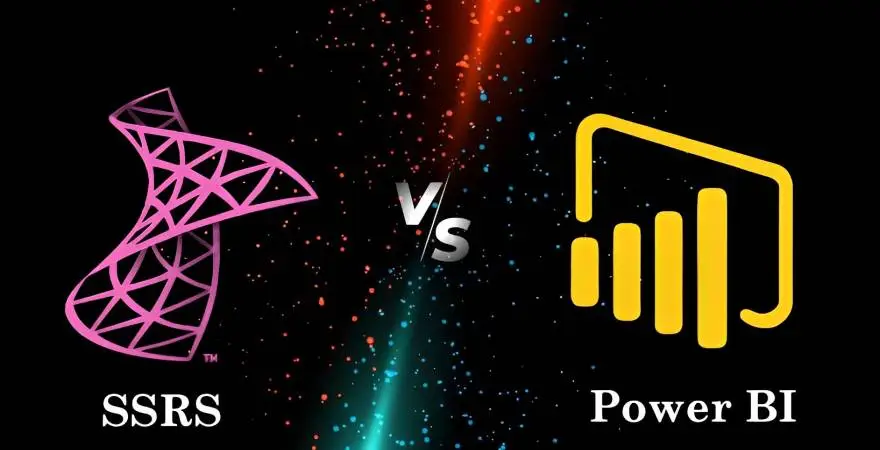
| Basis | Power BI | SSRS |
|---|---|---|
| Full form | Power Business Intelligence | SQL Server Reporting Services |
| History | Power BI was launched by Microsoft in 2014 as a free desktop version. Later, a paid version with extra features was introduced. | In 2004, Microsoft launched SSRS. It is a paid tool with a paid SQL server license. |
| Server license requirement | Power BI requires no server license. However, working on-premises only requires a report server. | SSRS requires an SQL server license to work and have add-on features. |
| Technology | Power BI offers data analysis and report creation benefits. | SSRS is server-based and allows users to quickly analyze big data and generate reports. |
| Accessibility | It can be accessed as mobile and desktop applications or opened on web browsers. | SSRS can only be accessed on desktop or web browsers. |
| Usage | It is an analytical and business intelligence tool for analyzing, transforming, visualizing, and modeling data. | This web-based server allows you to create, deploy, and manage reports. |
| Size limit | In the free version, Power BI holds 1GB of data per user, and in the paid version, it can hold upto 10GB. | SSRS holds a large chunk of data and has no such restricted limit for data. |
| Data sources | Power BI can extract data from anywhere without any problem. | SSRS extracts data from major SQL servers, data warehouses, and SQL analysis services. |
| Data dependency | It works by depending on both structured and unstructured data. | SSRS works on structured and semi-structured data. |
| Software updates | Microsoft updates Power BI almost every month with several new features and services. It increases its usability and interface. | Microsoft updates SSRS only once a year. |
| Implementation | Power BI works depending on AI insights or inputs. Therefore, it can be implemented easily. | Its implementation process is complex as SSRS works on manual efforts. Thus, it is a time-consuming process. |
| Cost to acquire | Power BI has free versions of desktops and applications. However, the benefits and features are very few in the free version. You can get its paid version to enjoy unlimited benefits | ASSRS is a web-based server and is totally a paid server. You must pay its premium and subscribe to SSRS to enjoy its benefits. |
| Technology tool | Power BI uses HTML 5 source and cloud-based SaaS as a modern technology tool. | SSRS, an old technology tool, uses the same visualization method. |
| Security | Power BI has advanced security features in its pro and premium versions only. | SSRS offers detailed security benefits that allow you to keep your files, folders, and reports safe and secure. |
| Machine learning or Artificial intelligence services | Many machine learning services are pre-built in Power BI. These services are sentiment analysis, text classifications, etc. | SSRS requires the implementation of programming languages like Python and R to perform multiple tasks better. AI and machine learning integration help a lot in the working of SSRS. |
| Customer base | Power BI has a wide range of customer base because it offers both free and paid versions. Furthermore, it works on mobile devices, making its accessibility easy for users. With a customer base of over 5 million, Power BI is growing rapidly. Its user-friendly interface has won the hearts of many, and the best thing about it is that it does not require any special training to program. | Till now, there are no confirmed numbers for the customer base. However, SSRS customers are mainly professionals and specialists. These professionals need specific training to develop reports and work on SSRS. However, SSRS is believed to have far fewer subscribers than Power BI. |
When to Choose Power BI Over SSRS?
Now that you understand the benefits and cons of Power BI, the question arises when you should choose Power BI over SSRS tools.
Here are some scenarios when Power BI is far better than the SSRS solution:
- If you need built-in features of machine learning services and artificial intelligence integration for your data analysis process
- When the data source is not an SQL server or SQL server data warehouse
- In the presence of unstructured or semi-structured data
- If you prefer a user-friendly interface
- When looking for a GUI-based drag-and-drop tool for data analysis and visualization
- In requirement of embedding data with custom applications
- If you are required to generate cloud-based reports
- And when you don’t know or want to do coding by yourself
In Which Areas SSRS is Better Than Power BI?
Power BI can have a better interface and mobile-friendly solution, but it can lag in many aspects.
To know when SSRS is better to choose over Power BI, check out the following scenarios:
- When you need high control over your data, you can opt for SSRS
- If you want to analyze and visualize data in your own way, you can choose SSRS, which allows you to input your coding to continue the data analysis process.
- If you need high security for reports, you can opt for SSRS.
- If you don’t want to pay for the Power BI Premium and Pro versions, opt for the SSRS version to get exclusive benefits at affordable rates.
- As an experienced SQL server professional, you can input codes and programming languages to work on SSRS.
Final Words
Once you understand the pros and cons of both Microsoft products, you can easily differentiate between Power BI vs SSRS. Power BI is becoming popular daily because of its easy-to-use interface and mobile-friendly solution. However, SSRS is best for professionals looking for more modern and high-level solutions, irrespective of premium cost.
The significant difference between Power BI and SSRS is that Power BI can be a good choice for everyone, but SSRS is an excellent solution for experienced professionals. So, in brief, we understand that SSRS requires technical expertise while Power BI is accessible to almost everyone. If you are a beginner data analyst, you can opt for the Power BI tool; if you are a more advanced and skilled SQL person, opt for SSRS or Power premium versions.
Furthermore, to learn more about these Microsoft tools and be an excellent data analyst, you can choose this CCSLA Data Analytics & Engineering Bootcamp program and learn all about data analytics, reporting, and engineering processes. You can boost your career as a successful data analyst with live instructor facilities, one-to-one mentorship, hands-on projects, and job placement assistance.
FAQs
Power BI is a cloud-based business analytics service provided by Microsoft that enables users to visualize and share insights from their data. It offers extensive data connectivity, built-in AI capabilities, interactive visualizations, and integration with other Microsoft products.
SQL Server Reporting Services (SSRS) is a server-based report generating software system from Microsoft. It is used for preparing and delivering a variety of interactive and printed reports. SSRS is part of the Microsoft SQL Server services suite and offers tools to create, manage, and deploy reports.
Power BI is primarily a cloud-based tool, though it also offers a desktop version and an on-premises server option with Power BI Report Server. SSRS, on the other hand, is a server-based solution that is installed and hosted within a company’s own servers and infrastructure.
Yes, SSRS reports can be integrated with Power BI. This integration allows users to pin visuals from existing SSRS reports to their Power BI dashboards, enabling a combined view of static and interactive reports.
Power BI is generally considered more user-friendly, especially for users without deep technical skills. It offers a more intuitive interface and easier report creation with drag-and-drop features, whereas SSRS requires more technical knowledge to set up and manage reports.
SSRS excels in pixel-perfect report rendering, which is crucial for standardized formatting requirements like invoices or regulatory reporting. It also supports a wider range of report customization and complex data-driven report generation, which can be more suitable for enterprise environments that require detailed, highly formatted reports.
Power BI offers superior mobile support with dedicated apps for iOS, Android, and Windows phones that allow users to access and interact with reports on the go. SSRS also provides a mobile report publisher, but its capabilities are generally considered less robust compared to Power BI.
Power BI has a tiered pricing model starting with a free version, which offers limited capabilities, followed by the Power BI Pro and Premium plans which include more features and larger data capacities. SSRS is included with SQL Server, so there is no direct additional cost for the software beyond the SQL Server licensing fees.
Power BI is optimized for handling large datasets through data modeling and compression algorithms, especially when using Power BI Premium, which provides dedicated capacity. SSRS can handle large datasets but may require more sophisticated database design and indexing to perform optimally.
The choice between Power BI and SSRS depends on your specific business needs. If you need dynamic, highly interactive reports and dashboards with advanced analytics capabilities, Power BI is the better choice. If your requirements are centered around static reporting, complex document generation, or precise report formatting, SSRS might be more suitable.






